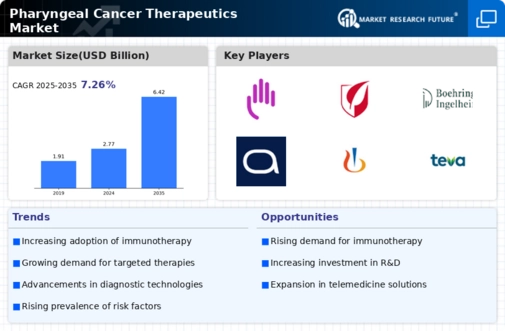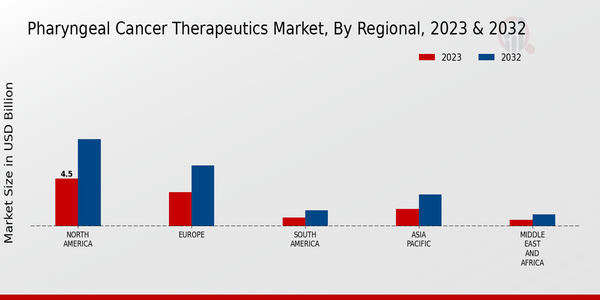Market Growth Projections
The Global Pharyngeal Cancer Therapeutics Market Industry is projected to experience substantial growth over the next decade. With a market value anticipated to reach 6.42 USD Billion by 2035, this growth trajectory reflects the increasing demand for effective treatment options. The compound annual growth rate (CAGR) of 7.94% from 2025 to 2035 underscores the market's potential as new therapies are developed and approved. This upward trend is indicative of the ongoing commitment to addressing the needs of patients suffering from pharyngeal cancer, ultimately leading to enhanced therapeutic landscapes.
Government Initiatives and Funding
Government initiatives and funding for cancer research significantly impact the Global Pharyngeal Cancer Therapeutics Market Industry. Various governments are allocating substantial resources to support research and development in oncology, particularly for less common cancers like pharyngeal cancer. These initiatives aim to foster innovation, enhance treatment accessibility, and improve patient outcomes. For example, funding for clinical trials and research grants encourages pharmaceutical companies to explore novel therapeutic agents. As a result, the market is likely to benefit from increased investment, leading to the introduction of new therapies and improved treatment protocols.
Advancements in Treatment Modalities
Innovations in treatment modalities significantly influence the Global Pharyngeal Cancer Therapeutics Market Industry. Recent advancements in targeted therapies, immunotherapies, and combination treatments have shown promising results in improving patient outcomes. For instance, the introduction of immune checkpoint inhibitors has transformed the therapeutic landscape, offering new hope for patients with advanced pharyngeal cancer. These advancements not only enhance survival rates but also reduce treatment-related side effects, making therapies more tolerable. The market is anticipated to grow at a CAGR of 7.94% from 2025 to 2035, driven by ongoing research and development efforts aimed at refining these therapeutic approaches.
Emerging Markets and Economic Growth
The emergence of new markets and economic growth in developing regions contribute to the expansion of the Global Pharyngeal Cancer Therapeutics Market Industry. Countries with improving healthcare infrastructure are increasingly investing in cancer treatment options, thereby enhancing access to therapies. This trend is particularly evident in Asia-Pacific and Latin America, where rising disposable incomes and government healthcare initiatives are facilitating the adoption of advanced therapeutic modalities. As these regions continue to develop economically, the demand for pharyngeal cancer therapeutics is expected to rise, further driving market growth.
Rising Incidence of Pharyngeal Cancer
The increasing incidence of pharyngeal cancer globally serves as a primary driver for the Global Pharyngeal Cancer Therapeutics Market Industry. According to recent statistics, the prevalence of this malignancy has been on the rise, particularly in regions with high rates of tobacco and alcohol consumption. This trend necessitates the development of effective therapeutic options, thereby propelling market growth. As the global population ages, the number of diagnosed cases is expected to increase, further emphasizing the need for innovative treatments. The market is projected to reach 2.77 USD Billion in 2024, reflecting the urgent demand for advanced therapeutic solutions.
Increased Awareness and Screening Programs
Heightened awareness regarding pharyngeal cancer and the importance of early detection plays a crucial role in the Global Pharyngeal Cancer Therapeutics Market Industry. Public health initiatives and educational campaigns have led to improved screening rates, enabling earlier diagnosis and treatment. This proactive approach is vital, as early-stage pharyngeal cancer is often more manageable and responsive to therapy. As awareness continues to grow, more individuals are likely to seek medical attention, resulting in an increased demand for therapeutic options. Consequently, the market is expected to expand, aligning with the projected growth to 6.42 USD Billion by 2035.














